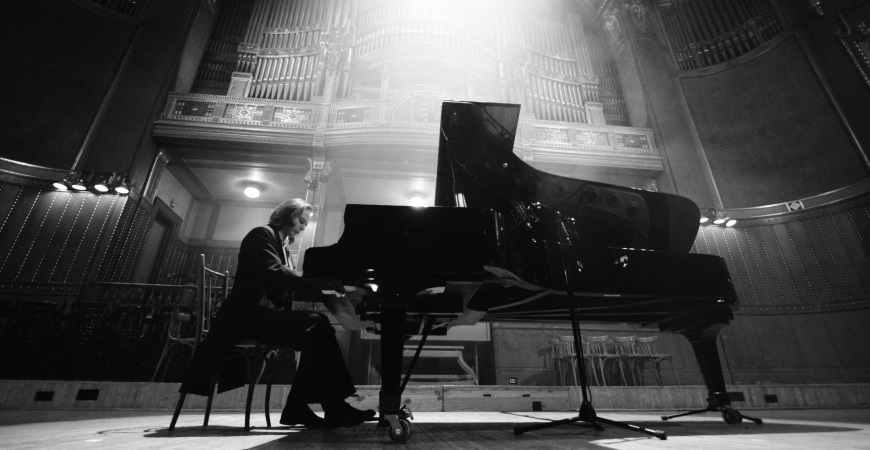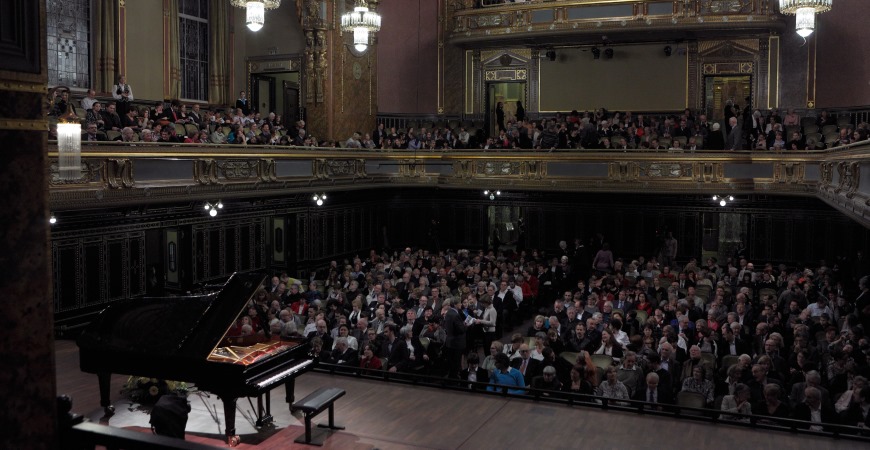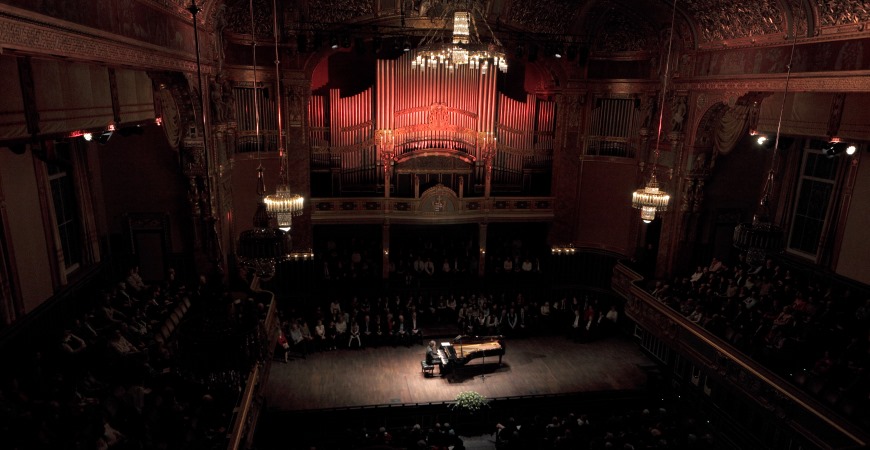The Piano Recital
In the following weeks many great pianists – including Gergely Bogányi and Tamás Érdi – will grace the stage of Liszt Academy’s Grand Hall. The secrets of the genre and the century old traditions of the Grand Hall known by many as the Mecca of pianists are revealed in János Mácsai’s article published in Liszt Academy Concert Magazine 2014 latest issue.
When the editor-in-chief of the concert magazine asked me to write about the traditions of piano recitals at the Liszt Academy, he granted me permission to be subjective. Nothing more was needed: gone was the objectivity of the music historian! Whenever I hear the words "piano recital" or read them somewhere, four decades of memories from the Liszt Academy Grand Hall swarm before my eyes. For the time being, I can still see the old brown wall paint, recall the oak yellow podium, the faint and warmer toned lighting, the threadbare and creaking seats, the characteristically groaning floor, and feel the boiling heat from April until November. I will need to attend the beautifully renovated hall a few more times before this image is rewritten in my head.

Photo: István Balázs
The venue for a piano recital for me is – and I'm being perfectly prejudiced – the Liszt Academy. What else can I say? True, I have had a great many experiences elsewhere; indeed my first true "imprinting" came at the Erkel Theatre with Richter's Schubert recital in 1973. And yet, for me, the Liszt Academy has become the holy shrine. According to my unrealistic reflex response (which they call a "pinched nerve" these days), a true piano recital cannot be held anywhere else. So what that I heard Cziffra at the Vigadó? Or Kocsis's solo recital at the Budapest Congress Center, Ránki at the MTA Congress Hall in the castle and later Schiff at the MTA Headquarters with Chain Bridge in the background? So what that I have been at every magnificent Palace of Arts evening over the past eight years, when world stars have seated themselves behind the piano? And I have mentioned only a few of those great halls and unforgettable concerts: I could mention countless others both in Hungary and beyond. Having said all that, at least until the recent restoration, there were also some less well-working aspects of the Grand Hall for piano recitals; for example, the less-than-satisfactory acoustics experienced in the first few rows of the central aisle on the ground floor, on the side balconies or even from the organ seats, which for a particularly popular concert would be given over to seating. In terms of being able to see the stage, the side balconies were far from ideal from the second row upwards.
As an adult, I don't now believe the children's story that there are NOT ghosts living in the walls. They do indeed live there and the Liszt Academy is the best proof of it. They move in, obviously following the path of the sound vibrations, and stay there. I mean, Dohnányi and Bartók gave solo recitals here. What sort of vibration is it that would dare to leave after that?
True, Liszt was unable to play in the hall, only in its "legal predecessor", but his shadow nonetheless emerges between the columns at piano recitals – and hopefully at other times. How could it not, since it was Liszt who created the genre. On 5 March 1839 in Rome, at the Palazzo Poli, behind the Fontana di Trevi, at one of Prince Dmitri Galitzin's evenings, for the very first time someone dared to give an entire concert filled by a single piano. Liszt did not require anything else, no singer, chamber music collaborator or orchestra. "Musikalischen Soliloquien" – musical monologues –, which is how he himself characterised the genre. Liszt can never be accused of false modesty, and with a "chivalrous gesture" turned towards the audience and, paraphrasing Louis XIV, declared: "Le concert, c'est moi!" The concert itself was a series of paraphrases: from Rossini (William Tell) to Bellini (I Puritani), and on themes submitted by the audience. But there were also virtuosic études and other "fragments". "Unbridled egotism," echoed the contemporary press. It is hard for path-breakers. Today we think of the bravery of the soloists, their loneliness, being at the mercy of themselves, conditions, inspiration, memory, the audience and the instrument. Because for many years now, solo recitals have not been about virtuosic self-display but are the most intimate existing form of expression, the most profound revelations and confessions.

Photo: Sándor Benkő
For me, this is the attraction of piano recitals (or other solo instrumental concerts, which sadly are rare). For this reason, I feel that the ghosts most often venture out of their hiding places during piano recitals. Sometimes their presence is almost tangible and we can see them inviting the latest most deserving vibrations to join them. From my collection of piano recital memories of the past four decades, a few instances come to mind when the spirits did indeed emerge. For example, when Annie Fischer gave her Beethoven cycle, playing all the sonatas for the 1977 bicentenary year. Or once later when Annie Fischer again played Chopin's Piano Sonata in B flat minor. In the three sets of eight bars that make up the central D flat major section of the funeral march, the spirits truly burst from the walls, entwined themselves around the piano, waltzed around Annie Fischer's famous hair bun, and refused to vanish back to their places.
In those days, on one occasion, a different fog descended in the corridors. True, it was not a piano recital but a violin concert. Menuhin had come and so many people wanted to get into the packed auditorium that they had to call the police, who dispersed the crowd with tear gas – perhaps the only case that tear gas has been used in Budapest between 1956 and 2006 (will this ever happen again because of a classical music concert?).
But the spirits could not enjoy a relaxed evening during Richter's concerts either. On one evening, so many people crammed into Mayakovsky Street that the trolley bus could not run and for half an hour, the crowd chanting his name: "Rich-ter, Rich-ter". Richter would have let them in but there was no room for a single additional hair in the hall (will they ever allow us to stand alongside the walls, in double lines again?). Every note Richter played was magic, an irreducible mixture of expectation, legend, positive prejudice and reality. The ghosts Richter left behind will have no language difficulties conversing with those bequeathed by Emil Gilels, but they would probably be able to make themselves understood to those of Perrahia and Brendel as well. And just what dances of the spirits occurred here thanks to native Hungarian artists. I hope that despite his promise otherwise, András Schiff will one day have a look at the newly-painted black-gold walls, because he is also on first name terms with those that live there and will be able to communicate with them through his playing.

Photo: Sándor Benkő
Part of the special magic of piano recitals, which of course can be achieved in any other type of musical performance, is that that the ghosts do not just nest in the walls but also in people's souls. It was a slightly expanded solo recital when the Klukon-Ránki duo first performed Liszt's transcription of Beethoven's Ninth Symphony, on 6 March 1999. Then I learned that music does have a direct physiological effect which for years can either fill or enervate one's energy reserves. On 4 January 2004 Zoltán Kocsis gave a solo recital featuring primarily romantic composers: possibly that was the last solo concert he gave here. But it left a different kind of lifelong impression on me. First, it caused several days of complete silence. My heart told me I shouldn't have spoken because what could I say? But it is inevitable, and at least I can try to speak differently than before.
The genre of the piano concert is not becoming extinct, but the fear that it could is not ungrounded. Song recitals have largely disappeared from the major halls and it is not as easy as it was three decades ago to attract audiences to other chamber genres, for example string quartets. I hope that Liszt's immodest idea, now nearly two centuries old, will survive for a little longer. Of course, talking about these concerts of the past is self-serving nostalgia; it means little for those who were not present. But the Liszt Academy is different. Because their ghosts live in the walls and at any time, the younger generation can encounter them.


